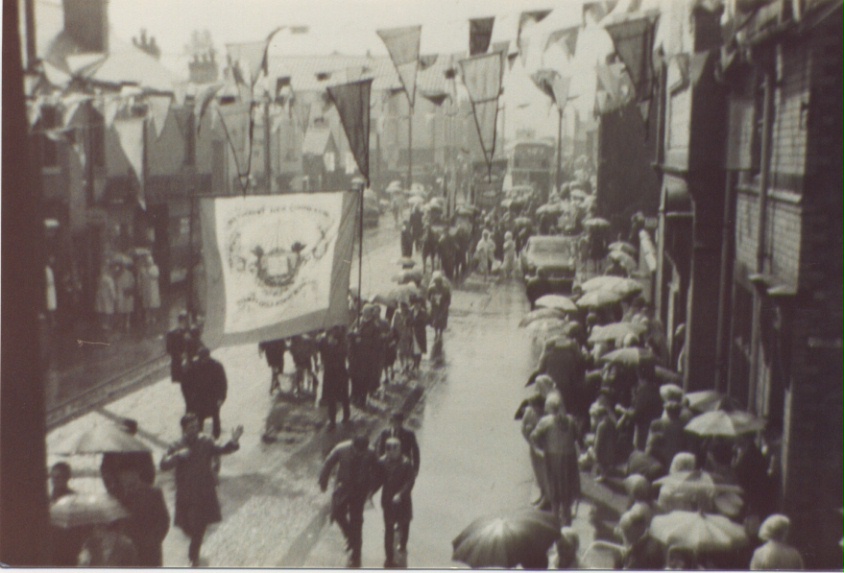
Thunderstorm at the Jubilee with the Methodist New Connexion banner (now Bistre Methodist Church: 4.2006)"

Mold Road, Buckley
July 1965
JUBILEE WEATHER 1975 - 2012
I can remember my two elder brothers, Frank and Allan, telling me as a boy that, when they attended the Buckley Jubilee with Zion Presbyterian Church, Brunswick Road, in the 1920's, the weather was always warm, sunny and dry on both the Tuesday Jubilee Day and the Ladies' Day following on the Wednesday.
With the summer of 2012 being one of the wettest I have recorded in 30 years, I thought I would check from my records for the past 37 years whether the second Tuesday in July still deserved this reputation, knowing that people's memory of the weather is not infallible. The results of my analysis follow:-
Temperature
By my calculations, the minimum and maximum temperatures one can expect on an average July day in the Buckley area, even with recent global warming changes, are 12.3C (54.1F) and 21.1C (70.2F). I have always used a maximum of 21.0C (70.0F) as a mark of a warm day, 26.5C (75.0F) as a mark of a very warm day and 32.0C (90.0F) as a mark of a hot day. When I analysed the past second Tuesdays in the month since the warm, dry summer of 1976, I got an average minimum temperature for 37 years of 12.0C (53.9F) and an average maximum of 20.3C (69.2F). The averages are therefore very close to what one would expect for any July day in Buckley but I did find that the last Jubilee Day that could be classed as warm was 2009.
What perhaps makes the figures more interesting though are the variations over the years. In more than half of them, the day failed to reach the normal average temperatures and Jubilee Day in 2012 was typical of these, being cool and cloudy with a maximum of 15.0C (59.0F), a north westerly wind but luckily with only slight rain. It compared with a run of four warm, sunny Jubilee Days we had from 2003 to 2006. However, it was similar to Millennium Year 2000 when we a dry, sunny Jubilee Day but with everyone shivering in a strong north wind and a maximum of 14.5C (58.1F) which is what one might expect on a typical day in late April. By comparison, Jubilee Day in 1983 dawned with a cloudless sky and a gentle south wind which allowed the temperature to get up to roasting 31.0C (87.8F) which approaches the highest maximum I have ever recorded at 33.5C (92.3F) in August 1990.
Rainfall
July is normally one of the drier months of the year unless we happen to suffer a downpour in a thunderstorm, and the average rainfall for a typical July day is only 1.6mm (1/16 inch). Since I started recorded rainfall in 1983, 17 of the Jubilee Days have been dry but the average rainfall for the 30 days is a surprising 2.7mm (1/10 inch). However, if one leaves out the Jubilee Day in the hot summer of 1995 when we had a severe thunderstorm in the early morning bringing 51.0mm (2.0 inches) out of the sky, the average falls back dramatically to a very small 1.4mm (1/20 inch) confirming Jubilee Day as being usually a reasonably dry day.
Wind
It would be very unusual to encounter a gale in July and a check on Jubilee Day winds shows that on more than half of the days, the wind speed was no more than a light or moderate level making the walk through the streets pleasant. On only four of the 37 days was the wind strong enough to give the Jubilee banner men any problems.
One would expect the winds in July to come from the southerly half of the compass, ie. anywhere between west through south to east, south easterlies coming from the Continent being usually particularly warm and pleasant in the summer. However, it is surprising that, on as many as 12 out of 37 Jubilee Days, the wind has come from the northerly part of the compass putting a decided chill into the air even if the wind was light. Only in the year 2000 did we have a combination of a really fresh wind and a northerly direction.
Author: Dunn, Neville
Tags
Year = 1965
Month = July
Event = Religious
Gender = Mixed
Landscape = Urban
People = Crowd
Extra = 1960s
Copyright © 2015 The Buckley Society